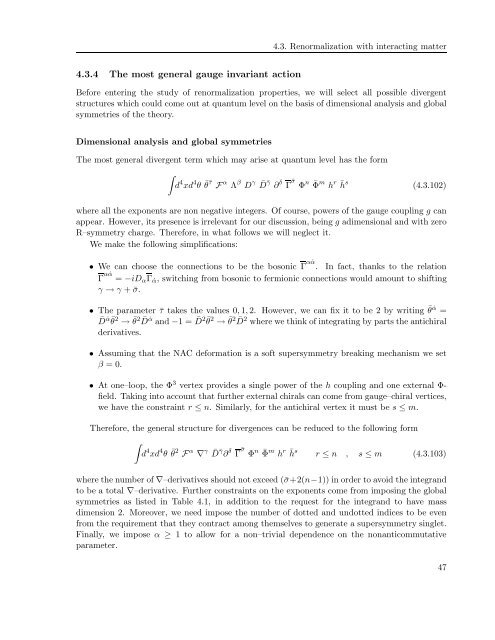Perturbative and non-perturbative infrared behavior of ...
Perturbative and non-perturbative infrared behavior of ...
Perturbative and non-perturbative infrared behavior of ...
You also want an ePaper? Increase the reach of your titles
YUMPU automatically turns print PDFs into web optimized ePapers that Google loves.
4.3.4 The most general gauge invariant action<br />
4.3. Renormalization with interacting matter<br />
Before entering the study <strong>of</strong> renormalization properties, we will select all possible divergent<br />
structures which could come out at quantum level on the basis <strong>of</strong> dimensional analysis <strong>and</strong> global<br />
symmetries <strong>of</strong> the theory.<br />
Dimensional analysis <strong>and</strong> global symmetries<br />
The most general divergent term which may arise at quantum level has the form<br />
<br />
d 4 xd 4 θ ¯ θ ¯τ F α Λ β D γ ¯ D ¯γ ∂ δ Γ ¯σ Φ n ¯ Φ m h r ¯ h s<br />
(4.3.102)<br />
where all the exponents are <strong>non</strong> negative integers. Of course, powers <strong>of</strong> the gauge coupling g can<br />
appear. However, its presence is irrelevant for our discussion, being g adimensional <strong>and</strong> with zero<br />
R–symmetry charge. Therefore, in what follows we will neglect it.<br />
We make the following simplifications:<br />
• We can choose the connections to be the bosonic Γ α ˙α . In fact, thanks to the relation<br />
Γ α ˙α = −iDαΓ ˙α, switching from bosonic to fermionic connections would amount to shifting<br />
γ → γ + ¯σ.<br />
• The parameter ¯τ takes the values 0,1,2. However, we can fix it to be 2 by writing ¯ θ ˙α =<br />
¯D ˙α¯ θ 2 → ¯ θ 2 ¯ D ˙α <strong>and</strong> −1 = ¯ D 2¯ θ 2 → ¯ θ 2 ¯ D 2 where we think <strong>of</strong> integrating by parts the antichiral<br />
derivatives.<br />
• Assuming that the NAC deformation is a s<strong>of</strong>t supersymmetry breaking mechanism we set<br />
β = 0.<br />
• At one–loop, the Φ 3 vertex provides a single power <strong>of</strong> the h coupling <strong>and</strong> one external Φfield.<br />
Taking into account that further external chirals can come from gauge–chiral vertices,<br />
we have the constraint r ≤ n. Similarly, for the antichiral vertex it must be s ≤ m.<br />
Therefore, the general structure for divergences can be reduced to the following form<br />
<br />
d 4 xd 4 θ ¯ θ 2 F α ∇ γ ¯ D ¯γ ∂ δ Γ ¯σ Φ n ¯ Φ m h r ¯ h s<br />
r ≤ n , s ≤ m (4.3.103)<br />
where the number <strong>of</strong> ∇–derivatives should not exceed (¯σ+2(n−1)) in order to avoid the integr<strong>and</strong><br />
to be a total ∇–derivative. Further constraints on the exponents come from imposing the global<br />
symmetries as listed in Table 4.1, in addition to the request for the integr<strong>and</strong> to have mass<br />
dimension 2. Moreover, we need impose the number <strong>of</strong> dotted <strong>and</strong> undotted indices to be even<br />
from the requirement that they contract among themselves to generate a supersymmetry singlet.<br />
Finally, we impose α ≥ 1 to allow for a <strong>non</strong>–trivial dependence on the <strong>non</strong>anticommutative<br />
parameter.<br />
47
















